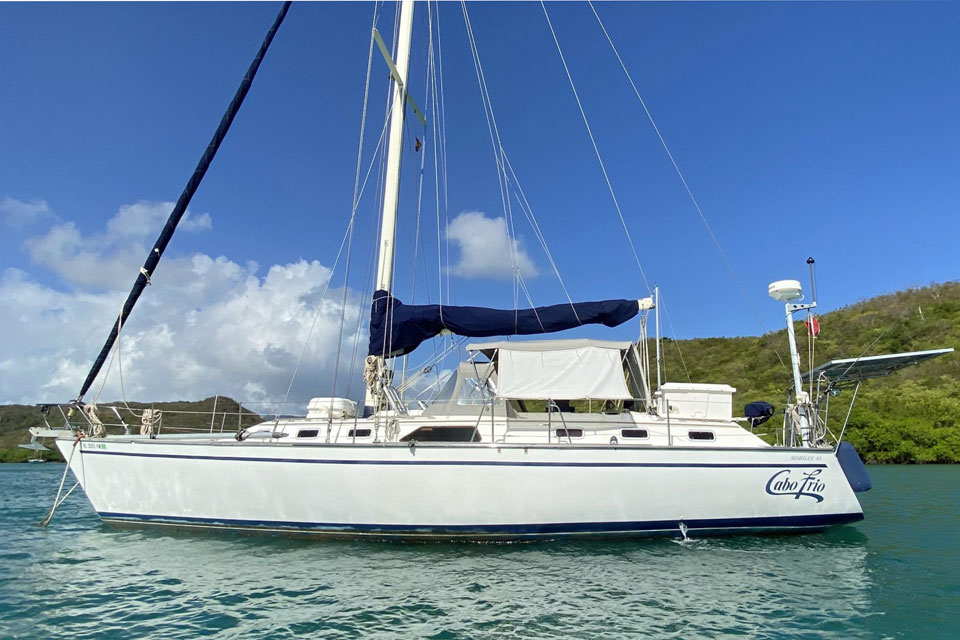- Home
- Cruising Yachts 40' to 45'
- Catalina Morgan 43
The Catalina Morgan 43 Sailboat
Specs & Key Performance Indicators
The Catalina Morgan 43 sailboat was designed by American naval architect Nelson Marek and built by Catalina Yachts in Largo, Florida. Marek's design emphasizes both functionality and performance, while Catalina Yachts' construction ensures the boat is durable and reliable.
 The Catalina Morgan 43, also known as the Morgan 43
The Catalina Morgan 43, also known as the Morgan 43Catalina Morgan sailboats are a result of the merger between Catalina Yachts and Morgan Yachts, which took place in 1984.
Published Specification for the Catalina Morgan 43
Keel & Rudder Configuration: Fin keel with skeg-hung rudder
Hull Material: Fiberglass
Length Overall (LOA): 13.1m (43'0")
Waterline Length (LWL): 10.8m (35'4")
Beam: 4.1m (13'6")
Standard Draft:1.83m (6'0")
Shallow Draft:1.52m (5'0")
Rig Type: masthead sloop
Displacement: 10,659kg (23,500lb)
Ballast: 3,719kg (8,200lb)
Designer: Nelson Marek
Builder: Catalina Yachts
Year First Built: 1985
Published Design Ratios for the Catalina Morgan 43
The Key Performance Indicators (KPIs)
Based on the Published design ratios, here are the sailing characteristics you might expect from the Catalina Morgan 43:
- Sail Area/Displacement Ratio - At 15.6, the Catalina Morgan 43 falls just below the threshold for being considered reasonably good in terms of performance capability. This indicates that the boat might be somewhat underpowered in light wind conditions. However, it should still perform adequately under moderate wind conditions, given that it is close to the threshold.
- Ballast/Displacement Ratio - A ratio of 34.9 suggests that the Catalina Morgan 43 will not be particularly stiff compared to boats with higher ratios (40 and above). This could imply that the boat might heel more easily under strong winds. However, it's important to note that the Ballast/Displacement Ratio does not consider the placement of ballast. If the ballast is low in the keel, it could still provide sufficient stiffness.
- Displacement/Length Ratio - With a Displacement/Length Ratio of 238, the Catalina Morgan 43 falls into the moderate displacement category. This means the boat should offer a balanced mix between stability and performance. It will require a moderate amount of sail area to reach its hull speed and should handle a variety of conditions well, neither too lightly nor too heavily disposed.
- Comfort Ratio - A Comfort Ratio of 30.2 indicates that the Catalina Morgan 43 lies within the range of a moderate bluewater cruising boat. This means it will offer reasonable comfort for its occupants, handling pitch, roll, and corkscrew motions relatively well, which is beneficial for longer passages and rougher seas. It should provide a decent level of comfort for extended cruising.
- Capsize Screening Formula - With a Capsize Screening Formula of 1.9, the Catalina Morgan 43 is on the safer side of the threshold (2.0). This value suggests that the boat has good bluewater capability and is less vulnerable to capsizing, making it suitable for ocean passages.
While these ratios provide a useful theoretical framework for understanding the design and potential performance of the Catalina Morgan 43, they each have limitations:
- Ballast/Displacement Ratio: This ratio does not account for the location or type of ballast. Ballast positioned lower in the keel or distributed in forms other than a shallow draft keel would significantly affect the boat's stability, thus potentially making a boat with a lower ratio more stable than it appears.
- Ted Brewer's Comfort Ratio: This ratio favors heavy displacement, narrow-beamed vessels with longer overhangs. Modern light-displacement, beamy cruisers with plumb bows might score poorly on this ratio even if they are well-designed for bluewater sailing and offer significant comfort to their crews. Therefore, newer designs might not be accurately represented by this ratio.
Overall, while the Catalina Morgan 43 seems well-rounded with moderate performance, comfort, and safety characteristics, it's important to consider the limitations of these theoretical ratios and to complement them with real-world experience and reviews when making decisions.
Here's how to calculate the KPIs yourself - without having to wrestle with the mathematics...
This article was written with the assistance of Gemini, a large language model developed by Google. Gemini was used to gather information, summarize research findings, and provide suggestions for the content and structure of the article.
Recent Articles
-
How a Marine AIS Unit Can Take Some of the Stress Out Of Sailing
Apr 03, 25 04:24 AM
But what type of marine AIS unit best suits your needs? A Class A Transponder, a Class B Transponder or an AIS Receiver unit coupled to your chartplotter? -
Marine AIS Issues: Your Questions Answered
Apr 03, 25 04:16 AM
Got a marine AIS issue? Odds are you'll find the answer here... -
Beneteau Oceanis 36CC Sailboat Specs & Key Performance Indicators
Apr 02, 25 10:09 AM
The Beneteau Oceanis 36CC sailboat specs and KPIs set out here say a lot about how this centre-cockpit sloop is likely to behave in a seaway...












